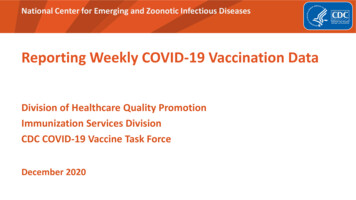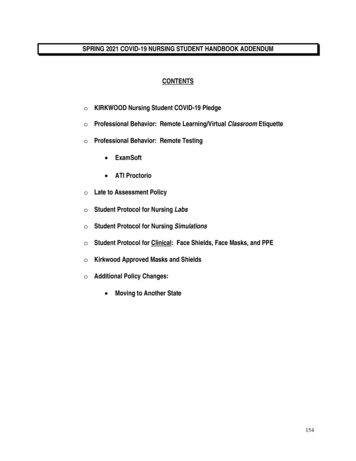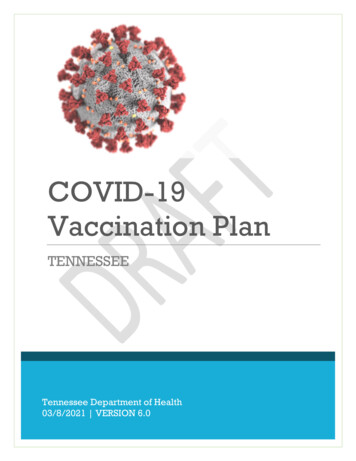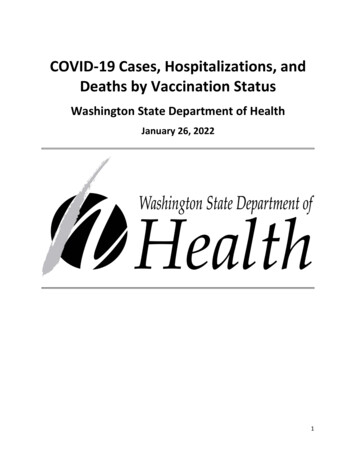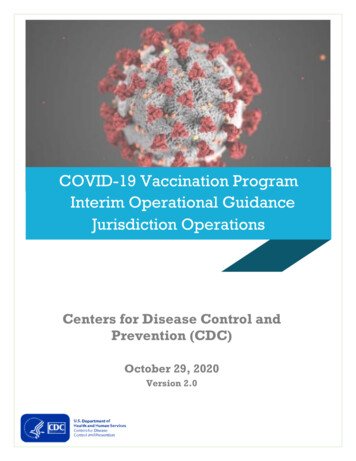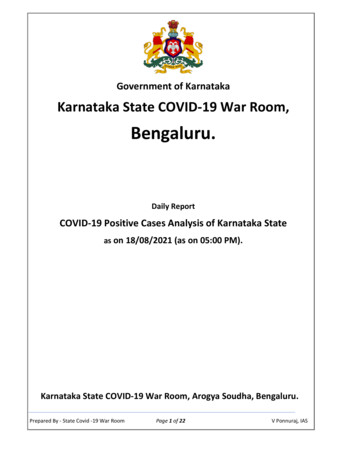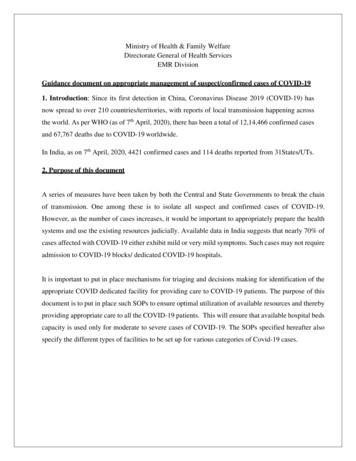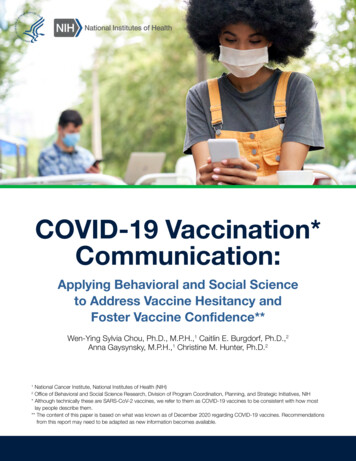
Transcription
COVID-19 Vaccination*Communication:Applying Behavioral and Social Scienceto Address Vaccine Hesitancy andFoster Vaccine Confidence**Wen-Ying Sylvia Chou, Ph.D., M.P.H.,1 Caitlin E. Burgdorf, Ph.D.,2Anna Gaysynsky, M.P.H.,1 Christine M. Hunter, Ph.D.2National Cancer Institute, National Institutes of Health (NIH)Office of Behavioral and Social Science Research, Division of Program Coordination, Planning, and Strategic Initiatives, NIH* Although technically these are SARS-CoV-2 vaccines, we refer to them as COVID-19 vaccines to be consistent with how mostlay people describe them.** The content of this paper is based on what was known as of December 2020 regarding COVID-19 vaccines. Recommendationsfrom this report may need to be adapted as new information becomes available.12
AcknowledgementsMembers of the NIH Behavior and Social Sciences Research-Coordinating Committee RapidWorking Group on COVID-19 Vaccine CommunicationRebecca Campo, Ph.D., National Heart, Lung, and Blood Institute, NIHStephanie George, Ph.D., National Institute of Arthritis and Musculoskeletal and Skin Diseases, NIHChris Gunter, Ph.D., National Human Genome Research Institute, NIHMonica Webb Hooper, Ph.D., National Institute on Minority Health and Health Disparities, NIHRosalind King, Ph.D., Eunice Kennedy Shriver National Institute of Child Health and Human Development, NIHBarbara Mulach, Ph.D., National Institute of Allergy and Infectious Diseases, NIHJanine Simmons, M.D., Ph.D., National Institute on Aging, NIHRona Siskind, M.H.S., National Institute of Allergy and Infectious Diseases, NIHRobin Vanderpool, Dr.P.H., National Cancer Institute, NIHExpert PanelistsMichele Andrasik, Ph.D., University of WashingtonEmily Brunson, Ph.D., Texas State UniversityAlison Buttenheim, Ph.D., M.B.A., University of PennsylvaniaJoseph Cappella, Ph.D., University of PennsylvaniaTara Haelle, M.A., Tara Haelle MediaAlex Kemper, M.D., M.P.H., M.S., Nationwide Children’s HospitalHeidi Larson, Ph.D., London School of Hygiene & Tropical MedicineSaad B. Omer, Ph.D., M.P.H., M.B.B.S., Yale UniversitySherry Pagoto, Ph.D., University of ConnecticutMegha Ramaswamy, Ph.D., M.P.H., University of KansasAmelie Ramirez, Dr.P.H., M.P.H., The University of Texas Health Science Center at San AntonioKen Resnicow, Ph.D., University of MichiganBrian Southwell, Ph.D., RTI InternationalVictor Sutton, Ph.D., M.P.P.A., Mississippi State Department of HealthKasisomayajula Viswanath, Ph.D., Harvard University
Table ofContentsContentsExecutive Summary1Introduction3Foundational Communication Considerations5Specific Objectives61. Define the goals of vaccination communication61.1 Establish top-line messages regarding COVID-19 vaccination71.2 Address vaccine hesitancy before and during rollout to reinforce COVID-19 vaccine confidence71.3 Mitigate the impact of COVID-19-related misinformation82. Identify the needs and perspectives of the intended audience102.1 Health care professionals112.2 Older adults and individuals with underlying medical conditions112.3 Non-health-care essential workers122.4 Racial and ethnic minority populations122.5 Vulnerable communities with limited access to routine vaccination services122.6 Individuals living in congregate settings132.7 Children and pregnant women133. Create and disseminate targeted and tailored messages for the intended audience143.1 Identify and partner with trusted COVID-19 vaccine messengers143.2 Create accurate, transparent, and truthful vaccine messages163.3 Frame vaccine acceptance as a social norm163.4 Use behavioral nudges173.5 Enact value-concordant messaging that is sensitive to the emotional state of the audience173.6 Creative strategies: Going beyond didactic vaccine messages18Conclusion19References19COVID-19 Vaccination Communication
ExecutiveSummaryAlthough newly developed COVID-19 vaccines are poised to be a powerful tool in the control of the devastatingCOVID-19 pandemic, the public’s confidence in and willingness to receive the vaccines will determine theoutcome of this mass-scale public health intervention. This report, which was developed in consultationwith leading experts in social and behavioral sciences and public health, outlines evidence-informedcommunication strategies in support of national COVID-19 vaccine distribution efforts across federalagencies and their state and local partners. The recommendations put forth are actionable and responsive tothe unique challenges faced by the United States in responding to the COVID-19 pandemic. The report relieson a few foundational practices of effective health communication, namely coordinated communicationand consistent messaging, trust building through partnerships, consideration of different healthliteracy levels in the population, and importantly, prioritizing equity in all aspects of communication. Webuild on these foundational principles to outline three intersecting considerations for communication efforts(What is being communicated, Who is the target of the message, and How the message is communicated),along with concrete recommendations for targeted and tailored communication that responds to the needsand perspectives of the intended audience.WHATDefine the goals of vaccination communicationIdentification of specific communication goals is necessary to inform the development of message contentand format. In addition to provision of top-line information regarding the vaccines, it is important to considerand address underlying reasons for vaccine hesitancy to instill trust. Doing so in an empathic way is crucialto avoid alienating those who have concerns about the development and deployment of these vaccines.Monitoring the spread of both general and COVID-19-specific vaccine misinformation, and taking steps tomitigate its impact, will be critical for successfully addressing vaccine hesitancy. It is important that the goalsof communication efforts—whether they focus on the delivery of top-line messages or on addressing vaccinehesitancy and misinformation—continue to evolve in response to emerging pandemic- and vaccine-relatedinformation and shifts in public sentiment to sustainably reinforce vaccine confidence.1COVID-19 Vaccination Communication
WHOIdentify the needs and perspectives of the intended audienceThe COVID-19 pandemic is having a disproportionate impact on communities already experiencing health andsocial disadvantages by virtue of their race, ethnicity, health status, age, access to health care, occupation,and socioeconomic conditions. To develop the most effective, trustworthy, and equitable communicationstrategies, the perspectives of the intended audience—including concerns, motivations, values, andinformation needs—must be considered. These factors should dictate vaccination communication priorities,including understanding and responding to different reasons for vaccine hesitancy in diverse communities.This document highlights some of the unique challenges and factors associated with vaccine hesitancy inspecific communities and describes methods that may help increase vaccine confidence in these populations.HOWCreate and disseminate messages tailored to the intendedaudienceGiven the diversity of factors that drive vaccine hesitancy in different groups, communication efforts cannottake a “one size fits all” approach. Effective communication goes beyond the provision of accurate content; itmust also be tailored to the community’s values and priorities and come from trusted messengers. The onlyway to truly “listen” to the community is to co-develop and co-disseminate COVID-19 vaccination messagesthrough meaningful partnerships with trusted information sources. In addition to partnering with trustedentities and leaders during message development, certain communication tactics may prove effective acrossa variety of communication campaigns. For example, it may be helpful to frame COVID-19 vaccination asa social norm that is collectively beneficial and acceptable and to reinforce the idea that vaccination is anapolitical, nonpartisan health care decision. Promotional materials, such as “I got the shot” stickers, mayhelp establish vaccination as a socially supported behavior and enhance vaccine confidence by makingvaccination behavior more visible.Furthermore, modifying the choice architecture in ways that make vaccination the easy and convenient action(for example, by asking people to opt out of rather than opt into vaccination at health care appointments) couldincrease the likelihood of vaccination uptake, while still preserving autonomy in decision making. However,efforts to promote the vaccines must also take care to ensure that all messages are accurate, transparent,and truthful and neither exaggerate nor minimize the vaccine benefits or risks. Similarly, overactivation offear and overly directive message framing should be avoided, because these approaches are likely to becounterproductive and heighten vaccine hesitancy. Ensuring value-concordant messaging and elicitingpositive emotions, whenever possible, will enhance trustworthiness and increase the impact of the message.Finally, several creative communication strategies, such as the use of personal narratives (e.g., from celebrityspokespeople) and short videos (e.g., “edutainment”), may help effectively convey key messages in anaccessible way.2COVID-19 Vaccination Communication
IntroductionThe historic public health crisis resulting from the SARS-CoV-2 (hereafter COVID-19) pandemic has resultedin tremendous mortality and morbidity, as well as unprecedented economic loss and disruption to dailylife in the United States and across the world. Long-term control of the COVID-19 pandemic hinges onthe development, distribution, and uptake of vaccines. Although highly effective COVID-19 vaccines havebeen developed rapidly and a phased plan for national vaccine distribution has been established, ensuringthe success of national vaccination efforts will require a communication plan to address vaccine hesitancyand foster vaccine confidence. To enhance acceptance and trust in COVID-19 vaccines among the diversepopulations in the United States, communication activities should be informed by insights from behavioral andsocial sciences and continuously adapt to a complex and dynamic vaccination landscape across all phasesof vaccine distribution and administration.Despite the considerable suffering and disruption caused by the COVID-19 pandemic, polls suggest that asizable proportion of the U.S. population either does not plan to receive a COVID-19 vaccine or is unsureabout receiving a vaccine.1,2 Furthermore, a recent report found that despite the disproportionate impact thepandemic is having on minority communities in the United States, only 48 percent of Black Americans and66 percent of Latinx individuals surveyed would receive the vaccine even if it was available for free.3 Thehesitancy observed regarding COVID-19 vaccines is, in many ways, understandable given the novelty of thevirus, mixed messages about the severity of the disease, concerns about the rapid vaccine developmenttimeline, and perceived politicization of the process.4 These COVID-19-specific concerns may be exacerbatedby factors that reduce vaccine confidence in general, including distrust in traditional sources of health information(e.g., government agencies, scientists, the medical system), the rapid and extensive spread of misinformationonline, and disinformation campaigns that take advantage of the divisive public discourse around vaccines.3,5,6In addition to vaccine hesitancy, the fact that most candidate vaccines require a two-dose regimen administeredseveral weeks apart7 creates additional challenges for full vaccine uptake. Communication efforts will needto make it clear that individuals will not only need to initiate the vaccine, but also to return to receive anothershot at the right time to be fully vaccinated. In addition to logistical complexities, the two-dose regimen couldadd to communication challenges if individuals experience unpleasant side effects in response to the firstdose, making them reluctant to complete the series.8,9 Experience with other multiple-dose vaccines, like theshingles vaccine, suggests that educational efforts that highlight the efficacy of the vaccine and set appropriateexpectations about any initial side effects will be crucial to overcoming this barrier.8,93COVID-19 Vaccination Communication
It is clear that public health entities charged with communicating about COVID-19 vaccines face notablechallenges, including a compressed timeline for developing communication strategies to educate the publicabout the vaccine and address vaccine hesitancy ahead of rollout. Moreover, vaccination communicationmust be connected to the broader context of COVID-19 pandemic control, including critical preventivebehaviors, such as mask wearing, hand washing, and social distancing. Consequently, the rapid, coordinateddissemination of effective messages will be an essential element in addressing one of the most significantpublic health challenges in decades. Although ensuring successful vaccine uptake across the nation will requireaddressing demanding logistical and structural challenges, strategic and evidence-informed communicationregarding vaccine safety, efficacy, distribution, and access will also play a key role in the complex nationalCOVID-19 vaccination process. Drawing on behavioral and social science research, in addition to establishingcollaborative partnerships with trusted community organizations, can increase the likelihood that COVID-19vaccine communication endeavors will be successful.To identify evidence-informed strategies for communicating about COVID-19 vaccines, the NIH Behavioraland Social Sciences Research Coordinating Committee formed a COVID-19 vaccine communication workinggroup in September 2020 and convened an expert panel on November 5, 2020. The panel, which comprised15 leading experts in public health and social sciences (e.g., communication, psychology, behavioraleconomics, health disparities, anthropology), focused on identifying evidence-informed communicationapproaches that could guide government entities in communicating COVID-19 vaccine-related informationto a variety of constituents. The panel also made recommendations about how these communicationstrategies could be optimized, tailored, targeted, and delivered to address the unique needs and perspectivesof diverse populations. The panel discussion formed the basis of this report, which is designed to summarizeevidence from behavioral and social science to inform COVID-19 vaccine communication efforts acrossU.S. federal agencies and partners at the state and local levels. This report begins by outlining foundationalconsiderations for any public health communication effort and then delves into more specific evidence-informedcommunication strategies for reducing hesitancy and enhancing confidence in COVID-19 vaccination.4COVID-19 Vaccination Communication
FoundationalCommunicationConsiderationsEffective health communication relies on foundational best practices. Although these are not the primary focusof this report, some of the COVID-19 vaccine communication recommendations highlighted in subsequentsections will build on these general best practices: Ensure coordinated communication and consistent messaging: Although a national strategy isimportant, sustained partnerships with state, local, and community organizations are critical, becausemost communication ultimately must be locally implemented and coordinated. Message framing maydiffer depending on the specific community of focus, but it is important to minimize conflicting ordistracting messages by keeping message content as consistent as possible. Foster transparency and build trust through partnerships: Presenting clear and accurateinformation that does not exaggrate or minimize the benefits or potential risks is vital. In addition,leveraging trusted sources to disseminate the messages is as essential as the content itself, and itcan be accomplished through sustainable partnerships between federal agencies and trusted entitiesor individuals who reflect the diversity and views of the intended audience. Consider the range of health literacy: Plain language and visual representations should be usedwhere possible. Additionally, communication strategies should be developed to accommodatedifferent levels of health literacy (e.g., the capacity to understand health information), digital literacy(e.g., the capacity to discern the credibility of online sources), and science literacy (e.g., understandingof the evolving nature of science). Furthermore, language preferences for those with limited Englishproficiency must also be taken into account. It is important that translations into other languages bedone in a culturally sensitive way so that the information is conveyed in an accurate, nuanced, andaccessible manner. Prioritize equity: Suboptimal communication has the potential to exacerbate health disparities andundermine the goals of fostering equity and trust. Communicators should make additional effortsto engage with and address the needs of vulnerable, underserved, and traditionally marginalizedpopulations during communication development and dissemination to avoid exacerbating disparities.Communication efforts should be sensitive to the fact that people may have to balance competingpriorities.5COVID-19 Vaccination Communication
SpecificObjectivesThis report highlights recommended practices drawn from behavioral and social science research that can beused to inform COVID-19 vaccine communication efforts. The intended users of this report are those chargedwith COVID-19 vaccine communication across federal health agencies and their partners at the state andlocal levels. The recommendations put forth in this report are evidence-informed, actionable, and responsiveto the unique circumstances and challenges facing the United States with regard to the COVID-19 pandemic.The recommended strategies are organized around three critical and interrelated strategic considerationsthat should guide the planning and implementation of COVID-19 vaccine communication:1. Define the goals of vaccine communication (What)2. Identify the needs and perspectives of the intended audience (Who)3. Create and disseminate messages tailored to the intended audience (How)The following sections provide details and examples for each of the strategic considerations. For anycommunication planning and implementation effort, all three considerations are important and may intersectin unique ways depending on the goals, target audience, resources, and time available for message tailoringand dissemination, among other practical factors.1. Define the goals of vaccination communicationThe first step in any communication effort should be to identify communication goals, because these goals willinform message content, format, mode of delivery, and required partnerships. Within the complex landscapeof COVID-19 control and risk mitigation are a number of distinct and high-priority communication goals—suchas conveying information about vaccine efficacy and safety, addressing vaccine hesitancy, or mitigating theimpact of misinformation—each of which may necessitate a different approach. On the next page, we outlinecritical considerations for establishing goals in COVID-19 vaccination communication efforts.6COVID-19 Vaccination Communication
1.1 Establish top-linemessages regardingCOVID-19 vaccinationKey goals of COVID-19 vaccinationcommunicationDeveloping a core set of messages, along with Provide assurance of vaccine safety andharmonized themes, images, and branding canefficacy.help ensure consistency of vaccine information Highlight the collective and individualacross different entities and sources. Top-linebenefits of vaccination.messages should provide accurate vaccine Explain the vaccine development, FDAinformation, acknowledge people’s concernsapproval, monitoring, and distributionwhere appropriate, and increase vaccineprocess.confidence and acceptance. Currently (as of Address vaccine hesitancy and respond toDecember 2020), critical content for COVID-19dominant concerns without judgment orvaccination messages should includeoverly directive language.assurance of vaccine safety and efficacy, Monitor misinformation and develop counterevidence that the benefits of vaccinationmessages.(i.e., protection from the virus) outweigh therisks, and a focus on the collective benefitsof high vaccination coverage. Emphasizingthe importance of completing the two-dose vaccine series will also be critical to ensure adherence. In addition,messages should establish social norms for vaccination—for example, by increasing the perception thatmembers of one’s social group plan to or have already been vaccinated10—and emphasize how herd immunityresulting from high vaccine uptake can protect the health and well-being of others.11,12 Finally, vaccinationmessages cannot be divorced from overall pandemic control efforts and the need for continued preventativebehaviors, including social distancing and mask wearing, until COVID-19 community transmission is halted.Messages should therefore clearly explain why vaccination alone, although beneficial, will not offer a quickend to the pandemic, at least in the early stages of rollout.This core content then can be adapted to fit a given community’s context, concerns, and preferredcommunication channels and developed into a tailored message (detailed in Section 3 below). Moreover, incrafting top-line messages, it will be critical to acknowledge and respond to the evolving scientific knowledgeabout various COVID-19 vaccines, which is an expected part of the vaccination administration process. Topline message content may need to be adjusted to account for any documented differences in the variousvaccines, who will receive them, and when they will receive them, so that this information can be quickly andconsistently communicated to the public.1.2 Address vaccine hesitancy before and during rollout toreinforce COVID-19 vaccine confidenceHesitancy or resistance to vaccination is multifaceted and requires different approaches based on the levelof hesitancy and the specific concerns driving hesitancy in the targeted community. For example, for some,vaccine hesitancy may stem from deep distrust of certain institutions, such as the media, governmentagencies, or pharmaceutical companies.13,14 For this group, communication from more trusted sources will be7COVID-19 Vaccination Communication
essential to reducing vaccine hesitancy. For others, hesitancy may be driven by concerns over the accelerateddevelopment timeline for COVID-19 vaccines. These individuals may be eager to gain knowledge fromtrusted experts about the steps taken to develop and evaluate the vaccine to support them in making aninformed decision about vaccination. Hesitancy arising from the false, but understandable, perception that thedevelopment and approval of COVID-19 vaccines has not been as stringent as the process for other vaccinescould be addressed by transparently explaining the vaccine development processes from clinical trialsto reviews by U.S. Food and Drug Administration (FDA) panels to authorize use to subsequent monitoringfor safety and effectiveness. It is important to note, however, that as knowledge about vaccines and rolloutevolves, new concerns and questions about particular vaccines may emerge, requiring government agenciesand their partners to adjust and respond quickly.In addition to unique concerns driving vaccine hesitancy, individuals’ personal values and beliefs, such asthose related to self-determination vs. fatalism or individualism vs. collectivism, are likely to influence uptake ofpreventative health measures, including vaccination.15–18 Understanding a community’s dominant values andbeliefs can help inform the development of effective messages to build vaccine confidence in the community.Furthermore, a distinction exists between those who may be hesitant about COVID-19 vaccines and thosewho have complete mistrust in vaccines. A poll conducted in November 2020 found that 42 percent ofAmericans are hesitant about receiving a vaccine, with 12 percent reporting not trusting vaccines in general.2Communicators should avoid grouping those who are only hesitant to vaccinate, but not entirely opposed,with people who are actively opposed to all vaccination. Research on childhood vaccines suggests that thereis a window of opportunity for influencing people who are initially vaccine hesitant before their viewsbecome ingrained.19 Therefore, hesitancy should be addressed early in the vaccine rollout process, becausethe longer people stay uncertain and their concerns go unaddressed, the less likely they are to get vaccinated.For those who have expressed a deeper general mistrust in vaccines, communication should still be balanced,empathetic, and compassionate. Even if this approach does not immediately lead to vaccine acceptance,it could help build relationships and trust, which may lead to greater willingness to consider vaccination in thefuture.20 Furthermore, attempting to directly contradict their anti-vaccine stance could lead to defensivenessand psychological reactance and further reduce their willingness to vaccinate.21 Messages targeting thisgroup might include acknowledgement of some of the dominant concerns about vaccines but emphasizethe evidence for the vaccine’s safety and efficacy.More generally, communication efforts targeting any group should avoid judgment, shaming, or excessivedirectiveness, because messages with these characteristics have been found to be counterproductivein previous public health campaigns.22,23 Avoidance of judgment allows people to feel that their concernsand values are respected and indeed “heard” by public health officials. Dismissing or leaving these vaccineconcerns unaddressed creates an opportunity for anti-vaccine groups to further sow doubt in vaccines andgain credibility for their own misinformation by effectively aligning their anti-vaccine messages with their targetgroups’ core concerns and values.241.3 Mitigate the impact of COVID-19-related misinformationThe spread of health-related misinformation was a significant public health concern well before the COVID-19pandemic. During the last decade, vaccine-related discourse online and in the media has been plagued8COVID-19 Vaccination Communication
by misinformation.25,26 Anti-vaccine groups have leveraged political and social divisions to diminish trust invaccines, pushed false narratives questioning the safety and effectiveness of vaccines, spread false claimsabout adverse outcomes, and downplayed the risks of the diseases vaccines protect against.24,27–30 In the caseof the current pandemic response, a recent joint statement from global public health organizations assertedthe extent to which misinformation and disinformation have undermined public health response.31 Social mediahas facilitated the rapid and widespread sharing of inaccurate information and outright falsehoods about manyaspects of the COVID-19 pandemic,32 from denying or downplaying the severity of the virus to casting doubton public health guidance to spreading vaccine conspiracy theories. COVID-19 vaccine communication effortscannot ignore misinformation and must take actions, informed by behavioral and communication research,to identify emerging rumors and respond in a way that is informed by behavioral science.Real-time, agile, and scalable monitoring of discourse concerning COVID 19 vaccination—includingconspiracy theories, rumors, and myths—can support a swiftly developed and implemented response.“Misinformation surveillance” efforts should identify the most prominent sources of misinformation, the tacticsbeing used, and the groups most at risk of being exposed to and influenced by the rumors. This information,in addition to data regarding the dynamics and patterns of misinformation spread, could help inform theappropriate response and best targets for intervention efforts. Understanding the emerging themes, values,logic, or concerns underlying the false claims or conspiracy theories can also inform the developmentof effective counter-messages. Developing competing messages that address the same concernsor beliefs held by those who might be vulnerable to misinformation could be important to countering theeffects of misinformation exposure, especially if these counter-messages can penetrate online informationsilos where misinformation circulates.33 Research suggests that exposure to detailed messages debunkingmisinformation can be effective34,35 and that exposure to multiple sources of information outside an individual’ssiloed communication circle can result in a more accurate credibility assessment.36 Therefore, broad exposureto multiple sources of factual counterarguments that have been developed according to best-practicerecommendations could be an effective way to induce misinformed individuals to update their beliefs.It is important to recognize that not every piece of misinformation requires an immediate counter-response.Public health organizations do not typically have the resources or capacity to address every piece ofmisinformation. When a rumor seems to be gaining widespread traction and has the potential to either causeharm or undermine critical health promotion efforts, however, intervention will be required. Correcting the falseclaim contained in the message, exposing the tactics used by disinformation agents, and inducing skepticismby highlighting the ulterior motives of these actors are all potentially effective strategies for mitigating the impactof misinformation.37–39 Communication research also points to a few general actions to avoid when respondingto misinformation: (1) Do not repeat the falsehood, because such repetitio
take a “one size fits all” approach. Effective communication goes beyond the provision of accurate content; it must also be tailored to the community’s values and priorities and come from trusted messengers. The only way to truly “listen” to the community is to co
